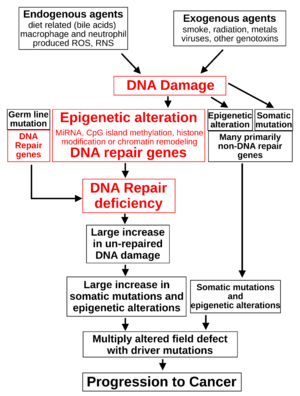Tumour facts for kids


A tumor is a swelling or a mass in the body. It can be caused by different things, but often it's because cells in a certain area have grown more than they should.
Contents
What is a neoplasm?
A neoplasm is a type of growth where the body's tissues grow in an unusual and sometimes too much way. The word "neoplasm" comes from old Greek words that mean "new formation" or "new creation."
Imagine your body is like a busy city with lots of buildings (these are like your tissues and organs). Normally, new buildings are built in an organized way when they are needed. But sometimes, in one part of the city, new buildings start popping up without a plan, growing in a way that isn't coordinated with the buildings around them.
When this abnormal growth forms a lump or a mass that you can see or feel, it's often called a tumor. So, a tumor is often a mass formed by a neoplasm. However, not all neoplasms form a solid mass. For example, some conditions where blood cells grow abnormally don't form a solid tumor.
Types of tumors
Not all tumors are the same! Doctors classify them into different main groups based on how they behave. It's like classifying different types of plants – some are harmless, and some need more attention.
- Benign tumors: These are like friendly neighbors. They are growths that stay in one place and don't spread to other parts of the body. They are usually contained and don't cause serious problems unless they grow very large and press on important things nearby. Examples include things like some types of skin moles or growths in the uterus called fibroids. Benign tumors do not turn into the more serious kind of growth we'll talk about next.
- Potentially malignant tumors: These are like neighbors who might cause trouble later. They are localized growths, meaning they stay in their original spot and don't invade or destroy the tissue around them right now. However, over time, they could change and become the more serious type of growth.
- Malignant tumors: These are the ones that need careful attention. They are commonly called cancers. Unlike benign tumors, malignant tumors can invade and damage the tissues around them. They can also sometimes spread to other parts of the body through the bloodstream or lymphatic system, forming new growths in distant locations. This spreading is called metastasis. Malignant tumors usually require medical treatment.
- Neoplasms of uncertain or unknown behavior: Sometimes, when doctors look at a growth, it's hard to tell right away if it's benign or malignant. These are put into this group until more is known.
Sometimes, a tumor that has spread from a malignant tumor in one part of the body to another is called a secondary neoplasm.
Neoplasm vs. Tumor: Are they the same?
The words "tumor" and "neoplasm" are often used together, but they aren't exactly the same thing.
The word tumor comes from a Latin word meaning "swelling." Long ago, this word was used for any kind of swelling, whether it was from an injury, an infection, or an abnormal growth. Today, in medicine, "tumor" is often used to mean a swelling or a mass that might be caused by an abnormal growth of cells (a neoplasm), or it could be a cyst (a sac filled with fluid).
The word neoplasm specifically refers to the abnormal growth of tissue. So, while many tumors are caused by neoplasms, not all tumors are neoplasms (like a simple cyst), and not all neoplasms form a solid tumor (like some blood conditions).
Doctors also use words like mass and nodule to describe lumps or swellings. A mass is usually a larger lump (often bigger than 20 millimeters, which is about the size of a small grape), while a nodule is usually smaller (less than 20 millimeters).
Why do tumors happen?
Tumors, especially malignant ones (cancers), happen because of changes inside the body's cells. Our cells have instructions, like a recipe book, called DNA. These instructions tell the cells how to grow, divide, and behave.
Sometimes, the DNA can get damaged or changed. Think of it like having a typo or a missing step in the recipe book. These changes are called mutations. Cells can also have other kinds of changes called epigenetic alterations, which are like changes in how the recipe is read or used, even if the words in the book are correct.
Our bodies have amazing repair systems that try to fix these DNA damages and changes. But sometimes, the damage is too much, or the repair systems aren't working perfectly. When this happens, a cell with damaged instructions might start growing and dividing uncontrollably, ignoring the body's signals to stop. This can lead to the formation of a neoplasm and potentially a tumor.
These changes can build up over time in a cell. It's like adding more and more typos to the recipe book until the cell doesn't know how to behave normally anymore.
What causes these DNA damages and changes?
- Things inside the body: Just normal processes happening in our cells can cause damage to DNA every day. Our bodies are constantly working to fix this.
- Things from outside the body: Certain things in our environment can also damage DNA. For example, too much sunlight can damage skin cells, and certain substances in things like tobacco smoke can damage cells in the lungs.
Sometimes, a person can be born with a higher chance of having problems with their DNA repair systems because of changes they inherited from their parents. This can make them more likely to develop certain types of tumors. However, many malignant tumors happen without being inherited; they are caused by changes that happen in a person's cells during their lifetime.
Scientists are studying how these changes happen and how they lead to the growth of tumors. They are also looking at how the area around the tumor, called the microenvironment, can affect its growth.
It's important to remember that not all swellings or lumps are caused by the abnormal growth of cells. Things like cysts (sacs of fluid), collections of blood from an injury, or even scar tissue can also form lumps that might be called tumors in a general sense, but they are not neoplasms and are not malignant.
Changes before a tumor forms
Scientists have learned that sometimes, before a malignant tumor (cancer) fully develops, there can be changes in the tissue around where the tumor starts. This area of changed tissue is sometimes called a field defect.
Imagine a patch of grass where some of the grass starts to look a little different – maybe it's growing faster or is a slightly different color. This patch is like a field defect. Within this patch, some of the grass might change even more, eventually leading to a weed (like a tumor) growing in that spot.
These field defects can have some of the same DNA changes or epigenetic alterations that are found in the tumor itself, but they haven't grown uncontrollably yet. Scientists are studying field defects to understand the early steps in how tumors form.
For example, in the colon (the large intestine), scientists have seen that areas of tissue around a colon cancer can show changes. It's thought that a single cell in the lining of the colon might get a DNA change, and its offspring cells with this change might grow and spread, forming a patch of slightly abnormal tissue (a field defect). Within this patch, further changes can happen in some cells, leading to smaller patches within the larger one, and eventually, one of these areas might develop into a polyp (a type of growth that can sometimes become malignant) or a malignant tumor.
Understanding field defects is important because it helps doctors look for early signs of potential problems and might lead to ways to prevent tumors from forming.
Genome instability
Malignant tumors (cancers) often have something called genome instability. This means that the DNA instructions within the cancer cells are very messy and prone to getting more changes (mutations and epigenetic alterations).
Think of the DNA as a very long instruction manual. In healthy cells, this manual is copied very carefully when cells divide. But in cells with genome instability, the copying process is faulty, or the repair systems that fix mistakes are not working well. This leads to many errors and changes accumulating in the DNA manual.
These extra changes can make the cancer cells behave even more abnormally. It's like having a recipe book where new typos and errors keep appearing, making the final dish turn out completely wrong and unpredictable.
Scientists believe that problems with DNA repair systems are a big reason why cancer cells have so much genome instability. If the repair systems aren't fixing the damage, the errors build up, leading to more mutations and epigenetic alterations. Some of these changes might give the cancer cells an advantage, helping them grow and spread.
Even within a single malignant tumor, the cells can be different from each other because of this instability. It's like having a city where different buildings have different versions of the building code, leading to a mix of structures.
See also
 In Spanish: Neoplasia para niños
In Spanish: Neoplasia para niños

